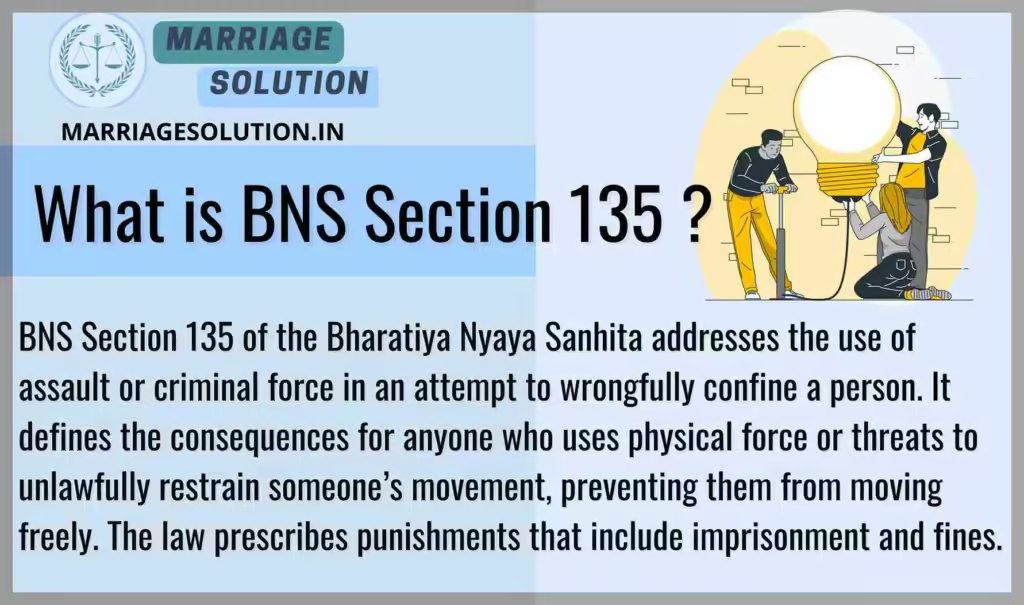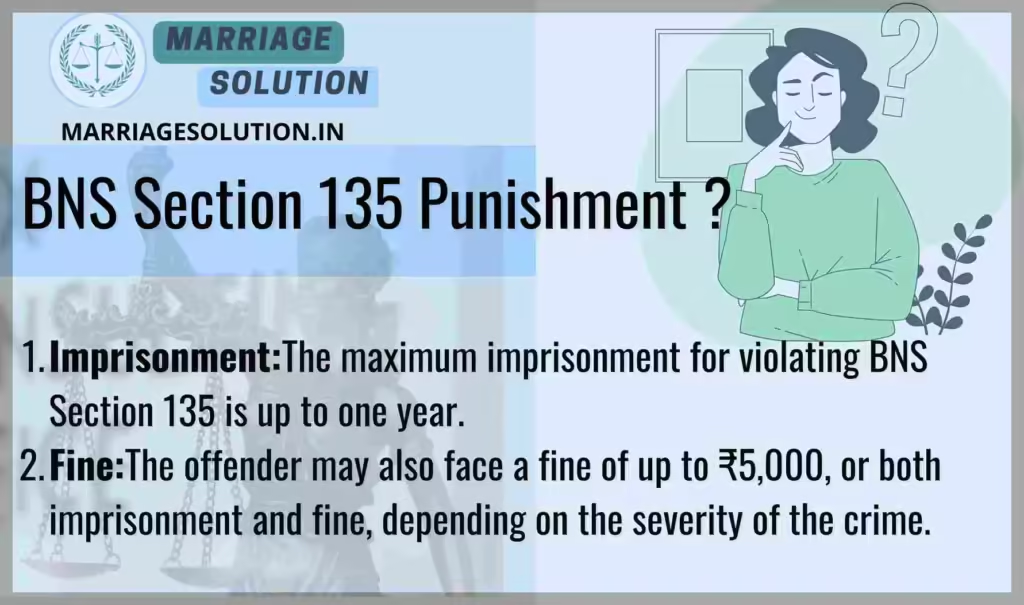Introduction of BNS Section 135
BNS Section 135 safeguards individual liberty by penalizing anyone who uses force or assault to attempt wrongful confinement. This provision recognizes that freedom of movement is a fundamental right, and even an attempt to restrict it unlawfully is a crime. With punishments including up to one year of imprisonment or fines up to ₹5,000, the section ensures that wrongful acts against personal freedom are deterred.
The Bharatiya Nyaya Sanhita (BNS) Section 135 replaces the old Indian Penal Code (IPC) Section 357.
What is section 135 of BNS ?
BNS Section 135 of the Bharatiya Nyaya Sanhita addresses the use of assault or criminal force in an attempt to wrongfully confine a person. It defines the consequences for anyone who uses physical force or threats to unlawfully restrain someone’s movement, preventing them from moving freely. The law prescribes punishments that include imprisonment and fines.

Bharatiya Nyaya Sanhita Section 135
“Whoever assaults or uses criminal force in attempting to wrongfully confine any person, shall be punished with imprisonment of either description for a term which may extend to one year, or with fine which may extend to five thousand rupees, or with both.”
This section punishes assault or use of force when the purpose is to wrongfully confine someone.
- Even if the confinement is not successful, the attempt itself is a crime.
- The maximum punishment is 1 year imprisonment, or a fine up to ₹5,000, or both.
- The offense is cognizable (police can arrest without a warrant), bailable (the accused can apply for bail), and non-compoundable (cannot be privately settled).
Key Elements of Section 135
- Assault or Criminal Force → Any act of violence or threat used to restrict someone’s movement.
- Attempt to Confine → Even an unsuccessful attempt to confine is punishable.
- Intent to Restrict Freedom → The offender must have intended to prevent the person from moving freely.
- Punishment → Jail up to 1 year, or fine up to ₹5,000, or both.
- Cognizable → Police can act without needing prior court approval.
- Bailable → The accused can be released on bail.
- Non-Compoundable → Cannot be withdrawn by compromise; it must go through court.
- Trial by Magistrate → Any Magistrate can hear the case.
Examples to Understand Section 135
Example 1 (Successful Confinement):
Ramesh locks his co-worker inside a cabin after an argument, preventing him from leaving.
Ramesh has used force to wrongfully confine the person → punishable under Section 135.
Example 2 (Attempted Confinement):
During a heated fight, Sita tries to push and block her neighbor from leaving the gate of their building. The victim escapes, but the attempt to confine using force is covered under Section 135.
Sita can still be punished even though confinement was not completed.
Why Section 135 is Important
- Protects personal liberty and free movement of citizens.
- Punishes both acts and attempts of wrongful confinement.
- Sends a message that forceful restriction of movement is a serious offense.
- Provides stronger deterrence compared to older IPC provisions.
Section 135 BNS Overview
Section 135 of BNS addresses situations where a person uses physical assault or force to try and confine another person unlawfully, preventing them from moving freely. The law outlines punishments to deter individuals from engaging in such wrongful acts.
BNS Section 135:10 Key Points
- Criminal Force and Assault:
BNS Section 135 specifically targets the use of physical force or assault to unlawfully confine someone. - Wrongful Confinement:
The key aspect is the attempt to confine someone without legal justification. Even if confinement isn’t fully successful, the mere attempt to confine is punishable. - Intent Matters:
The section emphasizes the intent to confine someone, making it punishable even if the act isn’t completed. - Imprisonment Penalty:
If found guilty, the offender can face imprisonment for up to 1 year, depending on the circumstances of the case. - Fine Penalty:
Along with imprisonment, a fine of up to ₹5,000 can be imposed. The punishment may include both imprisonment and fine. - Cognizability of Offense:
Since this is a cognizable offense, law enforcement authorities can arrest the accused without the need for a warrant. - Bail Provisions:
The offense is bailable, meaning the accused can apply for bail and avoid pre-trial custody. - Non-compoundable Offense:
This is a non-compoundable offense, meaning the case cannot be settled privately or withdrawn. It must go to court. - Trial by Magistrate:
The offense is triable by any magistrate, making it relatively easier and quicker to process legally. - Importance of Protection Against Confinement:
The section emphasizes the importance of protecting individuals from being wrongfully confined, safeguarding their freedom of movement.
Examples of BNS Section 135
- Example 1:
A person uses physical force to lock someone in a room against their will. Even if the confinement was brief or the person escapes, the use of force in this act can lead to punishment under BNS Section 135. - Example 2:
An individual tries to block someone’s way using force, attempting to prevent them from leaving a public place. Though the person was not fully confined, the attempt to confine is punishable under this law.
BNS 135 Punishment
- Imprisonment:
The maximum imprisonment for violating BNS Section 135 is up to one year. - Fine:
The offender may also face a fine of up to ₹5,000, or both imprisonment and fine, depending on the severity of the crime.

BNS 135 bailable or not ?
BNS Section 135 is a bailable offense, meaning the accused has the right to apply for bail and avoid pre-trial custody.
Comparison Table – BNS Section 135 vs IPC
| Section | Offence | Punishment | Bailable / Non-Bailable | Cognizable / Non-Cognizable | Trial By |
|---|---|---|---|---|---|
| BNS Section 135 | Assault or criminal force in attempt to wrongfully confine a person (using force to confine or attempt to confine someone unlawfully). | Imprisonment up to 2 years, or fine, or both. | Bailable | Cognizable | Any Magistrate |
| IPC Section 357 (Old) | Assault or criminal force used in attempting to commit wrongful confinement (old wording; covers similar conduct). | Imprisonment up to 2 years, or fine, or both. | Bailable | Cognizable | Any Magistrate |
BNS Section 135 FAQs
What does BNS Section 135 cover?
It deals with using assault or criminal force in an attempt to confine someone wrongfully.
What is the maximum punishment under BNS Section 135?
The maximum punishment is imprisonment of up to one year or a fine of ₹5,000, or both.
Is BNS Section 135 a cognizable offense?
Yes, it is a cognizable offense, meaning the police can arrest without a warrant.
Is BNS Section 135 bailable?
Yes, the offense is bailable, allowing the accused to apply for bail.
Can BNS Section 135 be settled outside of court?
No, it is non-compoundable, meaning the case must go to trial and cannot be settled privately.
Who can try cases under BNS Section 135?
Cases under this section are triable by any magistrate.
Need Legal Support?
If you’re facing court proceedings, marriage-related issues, or any legal matter, our team at Marriage Solution – Lawyer Help is ready to guide you. Just complete our easy online enquiry form, and we’ll connect you with the right legal assistance tailored to your needs.
Conclusion
Section 135 BNS plays a crucial role in protecting individuals from unlawful restraint of liberty. By criminalizing both the act and the attempt to confine someone through assault or force, it ensures that people cannot be intimidated, threatened, or unlawfully restrained. Compared to the old IPC, the punishments are stricter and fines are higher, making the law more effective in deterring such offenses.
Finished with BNS 135 ? Continue exploring the next provisions of the Bharatiya Nyaya Sanhita (BNS), 2023. Each section includes explanations, examples, and plain-language breakdowns for easy understanding.
- BNS 136 : Assault or criminal force on grave provocation.
- https://marriagesolution.in/bns_section/bns-136/
- 137 BNS : Kidnapping.
- https://marriagesolution.in/bns_section/137-bns/
- 138 BNS : Abduction.
- https://marriagesolution.in/bns_section/138-bns/
- 139 BNS : Kidnapping or maiming a child for purposes of begging.
- https://marriagesolution.in/bns_section/139-bns/
- 140 BNS : Kidnapping or abducting in order to murder or for ransom etc.
- https://marriagesolution.in/bns_section/140-bns/
Full IPC Section List: https://marriagesolution.in/ipc-section-list
All Indian Law & Blogs: https://marriagesolution.in/indian-law/
Full BNSS Section List: https://marriagesolution.in/bnss_section-list
